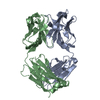+Search query
-Structure paper
| Title | Two classes of protective antibodies against Pseudorabies virus variant glycoprotein B: Implications for vaccine design. |
|---|---|
| Journal, issue, pages | PLoS Pathog, Vol. 13, Issue 12, Page e1006777, Year 2017 |
| Publish date | Dec 20, 2017 |
 Authors Authors | Xiangdong Li / Fanli Yang / Xule Hu / Feifei Tan / Jianxun Qi / Ruchao Peng / Min Wang / Yan Chai / Liying Hao / Junhua Deng / Chenyu Bai / Juan Wang / Hao Song / Shuguang Tan / Guangwen Lu / George F Gao / Yi Shi / Kegong Tian /  |
| PubMed Abstract | Pseudorabies virus (PRV) belongs to the Herpesviridae family, and is an important veterinary pathogen. Highly pathogenic PRV variants have caused severe epidemics in China since 2011, causing huge ...Pseudorabies virus (PRV) belongs to the Herpesviridae family, and is an important veterinary pathogen. Highly pathogenic PRV variants have caused severe epidemics in China since 2011, causing huge economic losses. To tackle the epidemics, we identified a panel of mouse monoclonal antibodies (mAbs) against PRV glycoprotein B (gB) that effectively block PRV infection. Among these 15 mAbs, fourteen of them block PRV entry in a complement-dependent manner. The remaining one, 1H1 mAb, however can directly neutralize the virus independent of complement and displays broad-spectrum neutralizing activities. We further determined the crystal structure of PRV gB and mapped the epitopes of these antibodies on the structure. Interestingly, all the complement-dependent neutralizing antibodies bind gB at the crown region (domain IV). In contrast, the epitope of 1H1 mAb is located at the bottom of domain I, which includes the fusion loops, indicating 1H1 mAb might neutralize the virus by interfering with the membrane fusion process. Our studies demonstrate that gB contains multiple B-cell epitopes in its crown and base regions and that antibodies targeting different epitopes block virus infection through different mechanisms. These findings would provide important clues for antiviral drug design and vaccine development. |
 External links External links |  PLoS Pathog / PLoS Pathog /  PubMed:29261802 / PubMed:29261802 /  PubMed Central PubMed Central |
| Methods | EM (single particle) / X-ray diffraction |
| Resolution | 2.5 - 35.0 Å |
| Structure data |  EMDB-6841:  PDB-5ys2:  PDB-5ysl: |
| Source |
|
 Keywords Keywords | VIRAL PROTEIN / fusion / IMMUNE SYSTEM / Fragment / FAB FRAGMENT / FICIN DIGESTION / INTACT ANTIBODY IgG1 |
 Movie
Movie Controller
Controller Structure viewers
Structure viewers About Yorodumi Papers
About Yorodumi Papers




 Suid herpesvirus 1
Suid herpesvirus 1
